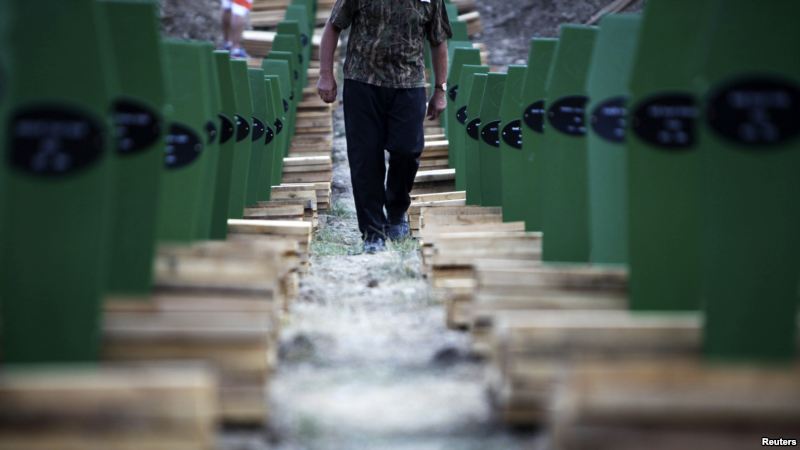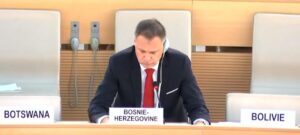By Michael Dobbs, Foreign Policy, Seventeen years after Srebrenica, the cover-up continues
Seventeen years after Srebrenica, the cover-up continues
Today marks the seventeenth anniversary of the fall of the United Nations “safe area” of Srebrenica, which led to the most serious war crime in Europe since World War II. In what has become an annual ritual, 520 more coffins were brought to the memorial complex outside the U.N. base at Potocari with the newly identified remains of Muslim men and boys executed by Bosnian Serb forces commanded by Ratko Mladic. (See photograph above.)
There is a simple — and horrifying — explanation for why it has taken so long to identify the dead. In a belated attempt to cover up the crime, Mladic’s men dug up mass graves containing the remains of the victims and scattered the bones all over north-east Bosnia. It took a massive international effort involving hundreds of investigators, forensic scientists, and DNA specialists to establish what happened. In some cases, remains were found in twenty different locations before being returned to loved ones.
It would be good if Bosnians of all ethnicities could remember this tragedy, pay their respects to the victims, and move on, as happened in Germany after World War II. Unfortunately, despite a wealth of corroborative evidence that around 7,000 prisoners were systematically executed, there are still many people who deny the basic facts of what happened at Srebrenica. As I showed in a previous post, this denial industry is being financed in part by the highest authorities of the Bosnian Serb statelet known as Republika Srpska.
Just a few years ago, in 2004, the Republika Srpska government apologized for the “enormous crimes” in the area of Srebrenica and issued an official report acknowledging that Serb forces had murdered thousands of Muslim prisoners. But the present Bosnian Serb president, Milorad Dodik, has backed away from this apology under the pressure of public opinion. Even though he personally had nothing to do with the crime, he has made himself complicit in the cover-up.
For a glimpse of the tactics used by the denialists, you need look no further than the comments section of my earlier blog post. Stephen Karganovic, who heads a Republika Srpska financed group calling itself the “Srebrenica Historical Project,” claims that most of the Srebrenica victims were killed in legitimate “combat operations” with Bosnian Serb forces. In order to sustain this argument, he cherry-picks selective portions of the evidence, frequently misquoting testimony to the Yugoslav war crimes tribunal.
Thus, for example, Karganovic draws on the testimony of a Bosnian army general, Enver Hadzihasanovic, quoting him as saying that “2,628 officers and soldiers of the 28th Division were killed in the post-July fighting from Srebrenica to Tuzla.” As a reader pointed out, this is a complete distortion of the general’s testimony, which you can find here. (See line 20 of page 9532.) He testified that 2,628 men of the 28th Division were killed — but did not make any determination about how many of these men were killed in fighting or in mass executions.
If Karganovic cannot be trusted to quote tribunal witnesses accurately, his entire “scholarship” is open to question. When challenged on the accuracy of his quote, he maintained that “it would seem likely that there must have been casualties on the Muslim side” as a result of fighting. That is no doubt the case, but it is altogether different from attributing to a Bosniak general the claim that 2,628 members of the 28th Division were killed in combat.
Another argument frequently employed by Karganovic is that the DNA evidence collected from the remains of Muslim victims tells us nothing about the cause of death. That is true, if you look at the evidence alone, out of context with the rest of the crime scene investigation. In order to understand the significance of the DNA evidence, you have to consider it in relation to everything else, including soil samples, pathologist reports, eyewitness testimonies (not just by Muslim survivors but also by their executioners).
The Srebrenica crime scene was like a gigantic jigsaw puzzle deliberately scrambled by the perpetrators that took more than a decade of hard investigative work to reassemble. Karganovic’s technique is to seize on individual pieces of the jigsaw puzzle — a contradictory piece of evidence here, some misquoted testimony there — in an effort to tell a completely different story. It is a technique that suits the purposes of those determined to deny the truth, including his Republika Srpska paymasters, but it should not fool anyone else.


